The Effects of Different Rotations of Beans, Maize, and Cabbage on Soil Moisture and Economic Benefits
Abstract
:1. Introduction
2. Materials and Methods
2.1. Site Description
2.2. Experimental Design
2.3. Determination Items and Methods
2.3.1. Soil Water Content
2.3.2. Evapotranspiration and Water Use Efficiency
2.3.3. Crop Yield
2.3.4. Economic Benefit
2.4. Data Statistics and Analysis
3. Results
3.1. The Impact of Various Crop Rotation Combinations on Soil Water Retention
3.2. Effect of Various Crop Rotations on Vertical Changes in Soil Water Potential in the 0 to 200 cm Soil Horizon
3.3. Effect of Different Crop Rotation Combinations on ET
3.4. Effects of Different Crop Rotation Combinations on Crop Economics and Water Use Efficiency
4. Discussion
5. Conclusions
Author Contributions
Funding
Institutional Review Board Statement
Informed Consent Statement
Data Availability Statement
Conflicts of Interest
References
- Hao, K.D. The Influence of Crop Rotation System Productivity and Water Use Efficiency for Different Crop Rotation in Semi-Arid Areas; Shanxi Agricultural University: Jinzhong, China, 2014. [Google Scholar]
- Guo, Z.L.; Lu, C.D.; Sun, C.Q. Study on multi-efficiency-cropping modes for dryland areas in east mountain in central part of Shanxi province. J. Shanxi Agric. Sci. 2012, 40, 628–631. [Google Scholar]
- Xia, M.; Zhong, W.; Ouyang, L.; Zhang, Z. Research status of continuous cropping obstacles in China from 1989 to 2018: Based on bibiometric analysis and knowledge mapping of CNKI. J. Agric. 2021, 11, 46–54. [Google Scholar]
- Song, L.P.; Luo, Z.Z.; Li, L.L.; Cai, L.Q.; Zhang, R.Z.; Niu, Y.N. Effect of lucerne-crop rotations on soil physical properties in the semi-arid Loess Plateau of central Gansu. Acta Prataculturae Sin. 2015, 24, 12–20. [Google Scholar]
- Li, M. Comprehensive Evaluation of Different Crop Rotation Way in Semi Arid Area; Shanxi Agricultural University: Jinzhong, China, 2015. [Google Scholar]
- Kang, S.; Shi, W.; Zhang, J. An improved water-use efficiency for maize grown under regulated deficit irrigation. Field Crops Res. 2000, 67, 207–214. [Google Scholar] [CrossRef]
- Wang, X.C.; Li, J.; Jiang, B.; Hu, W. Simulation of yield and soil desiccation effects of continuous spring maize in different precipitation areas of the Loess Plateau. Acta Ecol. Sin. 2009, 29, 2053–2066. [Google Scholar]
- Liu, C.X.; Li, M.; Du, T.Q. Effects of different pre-cropping patterns on Soybean yield and soil moisture in semi-arid areas. Crops 2017, 3, 121–126. [Google Scholar]
- Xu, B.C.; Shan, L.; Chen, Y.M. Soil moisture effect and its influencing factors of vegetation construction in semi-arid area of Loess Plateau. Sci. Soil Water Conserv. 2003, 4, 32–35. [Google Scholar]
- Liu, Z.M.; Shan, L.; Deng, X.P. Study on grass-grain crop rotation system in south Ningxia hilly area Ⅱ. field water balance under different crop rotatiun systems. J. Soil Water Conserv. 1993, 4, 67–71. [Google Scholar]
- Karandish, F. Improved soil–plant water dynamics and economic water use efficiency in a maize field under locally water stress. Arch. Agron. Soil Sci. 2016, 62, 1311–1323. [Google Scholar] [CrossRef]
- Zhang, Q.X.; Song, N.P.; Wang, L.; Chen, L. Variation of soil moisture under potato cropping and its influences on yield in mountainous area of southern Ningxia Hui autonomous region. Bull. Soil Water Conserv. 2010, 30, 81–85. [Google Scholar]
- Xie, J.; Wang, L.; Li, L.; Anwar, S.; Luo, Z.; Zechariah, E.; Kwami Fudjoe, S. Yield, economic benefit, soil water balance, and water use efficiency of intercropped maize/potato in responses to mulching practices on the semiarid loess plateau. Agriculture 2021, 11, 1100. [Google Scholar] [CrossRef]
- Wang, C.; Min, L.; Zhang, J.; Li, Y.; Liu, X.; Lü, Y.; Feng, X.; Fu, B. Vegetation restoration dominates increase in water use efficiency in drylands of China. Ecol. Indic. 2022, 145, 109703. [Google Scholar] [CrossRef]
- Li, Y.X.; Chen, W.; Sun, C.J. Soil moisture characteristics and their response to rainfall in cultivated land and abandoned land in loess hilly region. J. Arid Land Resour. Environ. 2021, 35, 114–120. [Google Scholar]
- Han, L.; Ding, J.; Han, Q.; Ding, R.; Nie, J.; Jia, Z.; Li, W. Effects of alfalfa-grain(oil) crop plowing rotation on soil moisture and crop yield in Loess Plateau. Trans. Chin. Soc. Agric. Eng. 2012, 28, 129–137. [Google Scholar]
- Zhang, H.J.; Fu, X.; Ma, S.W. Soil root distribution and water infiltration characteristics of different crop farmlands in Simian Mountain, Chongqing. Soil Water Conserv. Sci. China 2023, 21, 137–144, (In English and Chinese). [Google Scholar]
- Huang, M.B.; Dang, T.H.; Li, Y.S. Effect of advanced productivity in dryland farming of the Loess Plateau on soil water cycle. Trans. Chin. Soc. Agric. Eng. 2002, 6, 50–54. [Google Scholar]
- Tan, X.L.; Guo, T.W.; Zhang, P.L.; Zeng, J.; Liu, X.W. Effects of different rotation patterns with multiple cropping on water consumption and yield of potato. Agric. Res. Arid Areas 2021, 2, 137–142+149. [Google Scholar]
- Wang, X.C.; Li, J.; Hao, M.D. Simulation of sustainable use of soil water in dry land for alfalfa-grain rotation system at Changwu arid-plateau of China. Trans. Chin. Soc. Agric. Eng. 2011, 27, 257–266. [Google Scholar]
- Kresović, B.; Tapanarova, A.; Tomić, Z.; Životić, L.; Vujović, D.; Sredojević, Z.; Gajić, B. Grain yield and water use efficiency of maize as influenced by different irrigation regimes through sprinkler irrigation under temperate climate. Agric. Water Manag. 2016, 169, 34–43. [Google Scholar] [CrossRef]
- Tucker, B.B.; Cox, M.B.; Eck, H.V. Effects of rotation, tillage methods, and N fertilization on winter wheat production. Agron. J. 1971, 63, 699–702. [Google Scholar] [CrossRef]
- Mao, G.L.; Hu, D.Y.; Xu, X.; Ma, H. Effects of alfalfa post-harvest rotation on water use efficiency and crop yield in arid sandy area. J. Soil Water Conserv. 2015, 29, 219–224. [Google Scholar]
- Bai, W.X.; Li, J.; Wang, Y.L.; Wang, L. Effects of different tillage methods on soil water and crop yield of winter wheat-spring maize rotation region in Weibei highland. Sci. Agric. Sin. 2014, 47, 880–894. [Google Scholar]
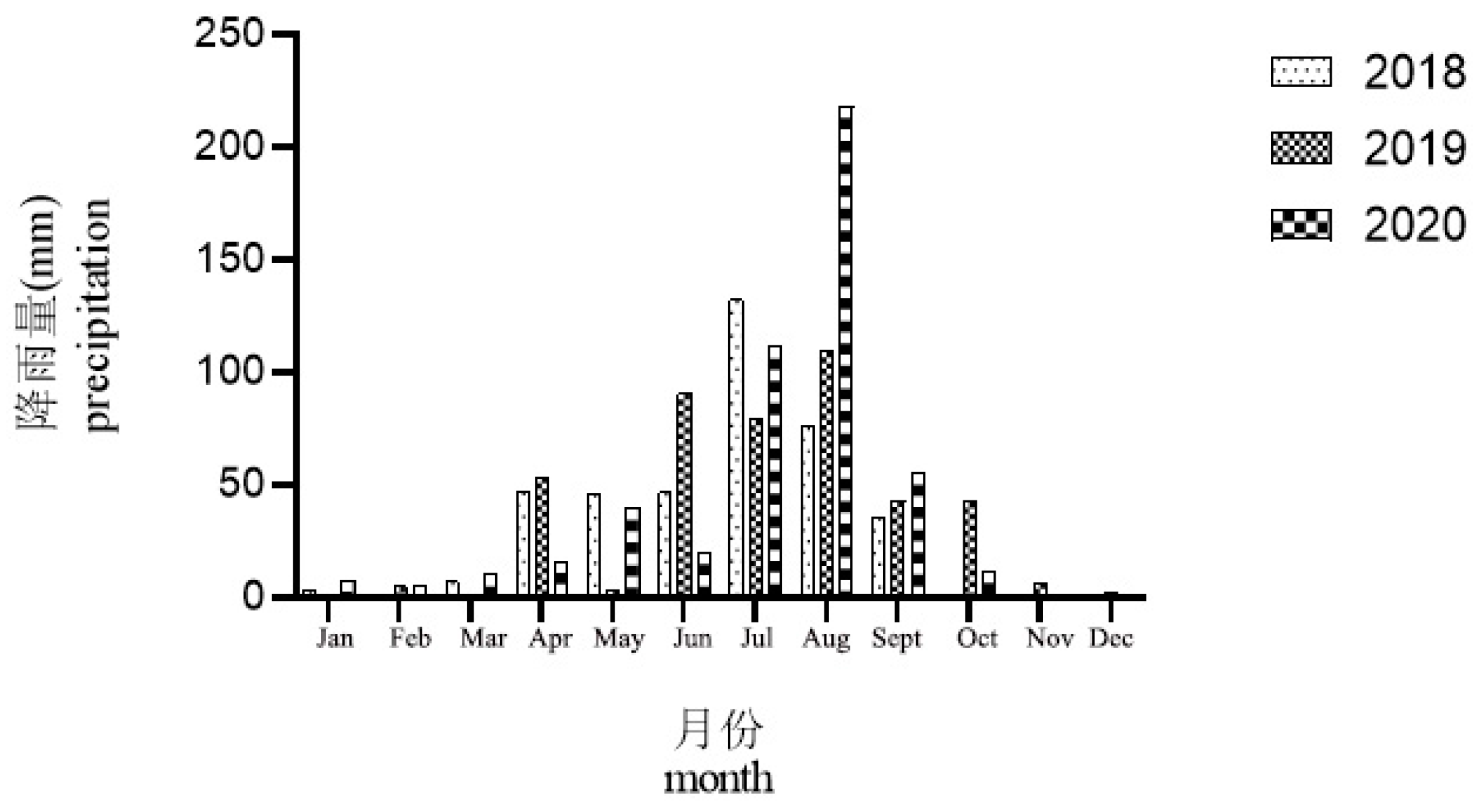
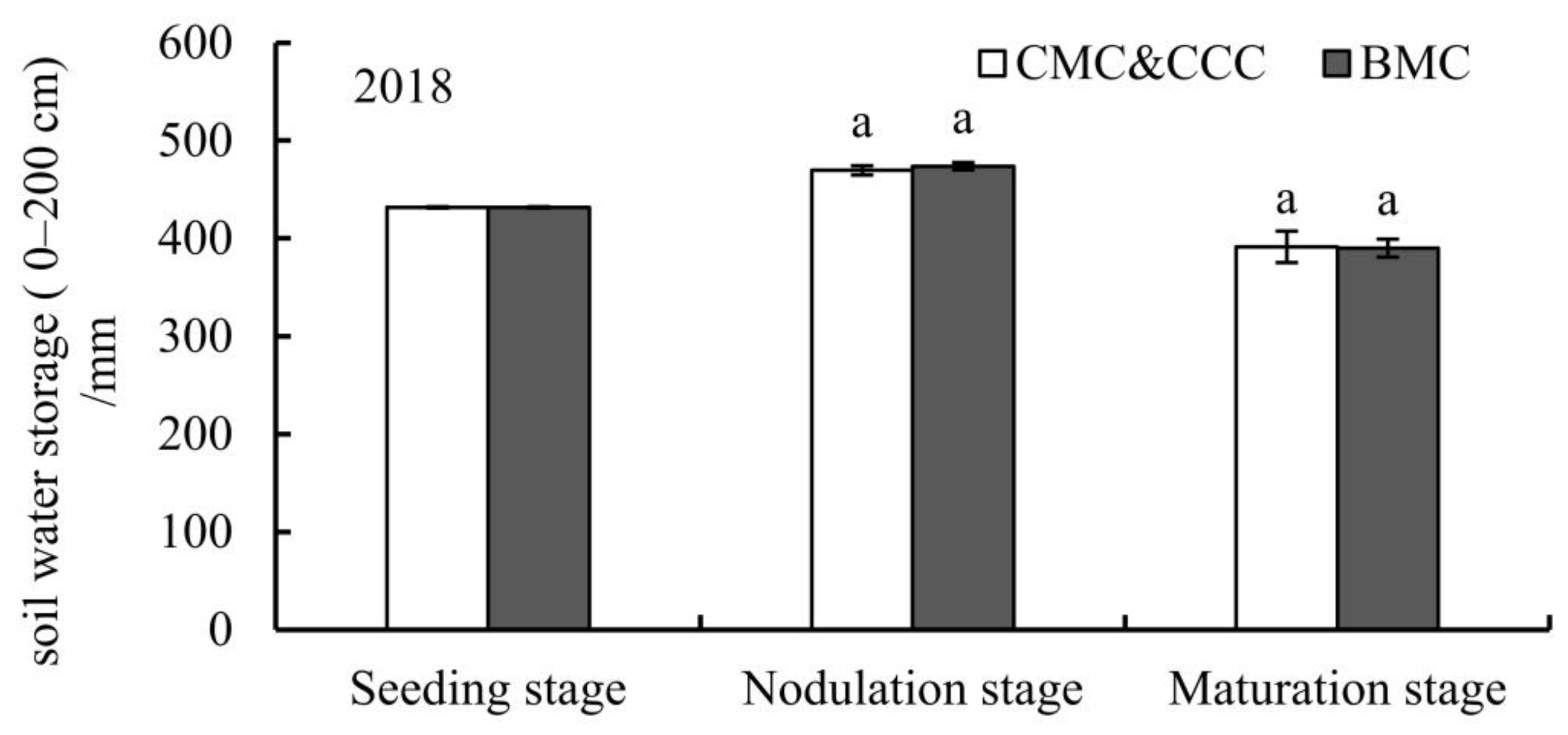

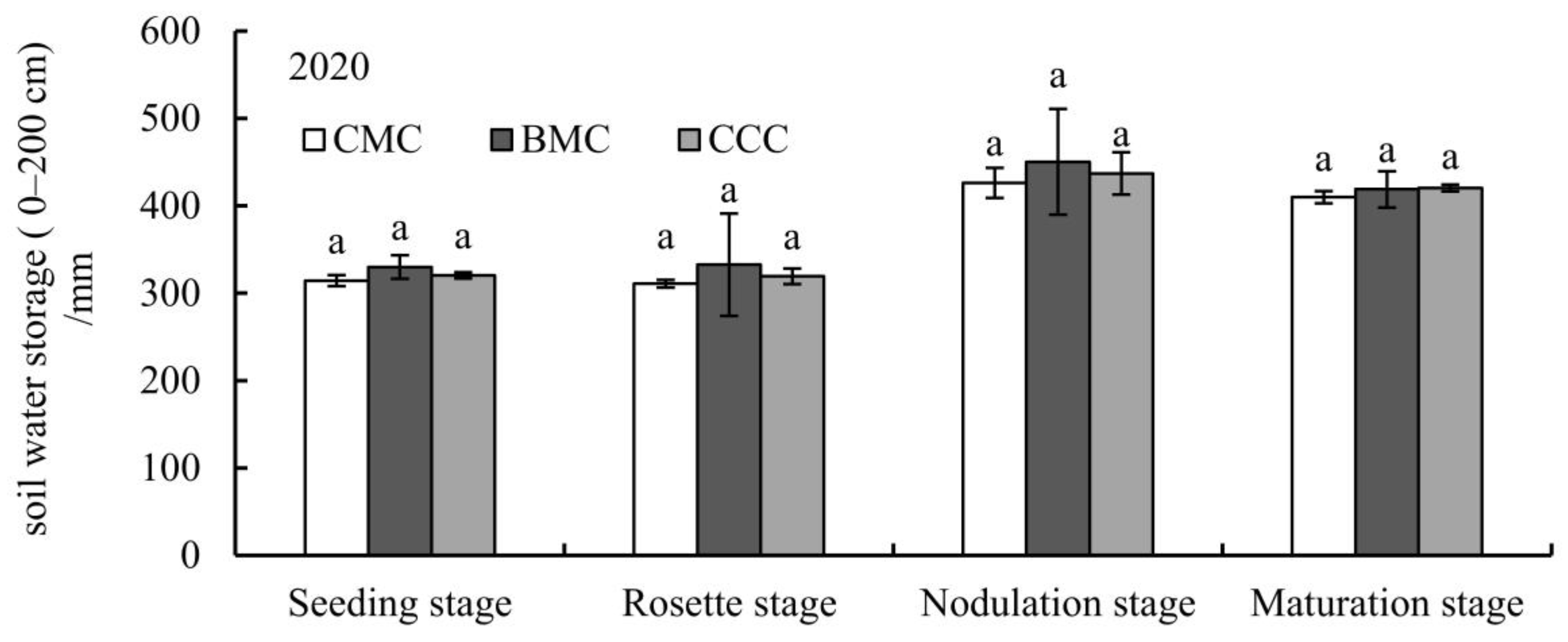
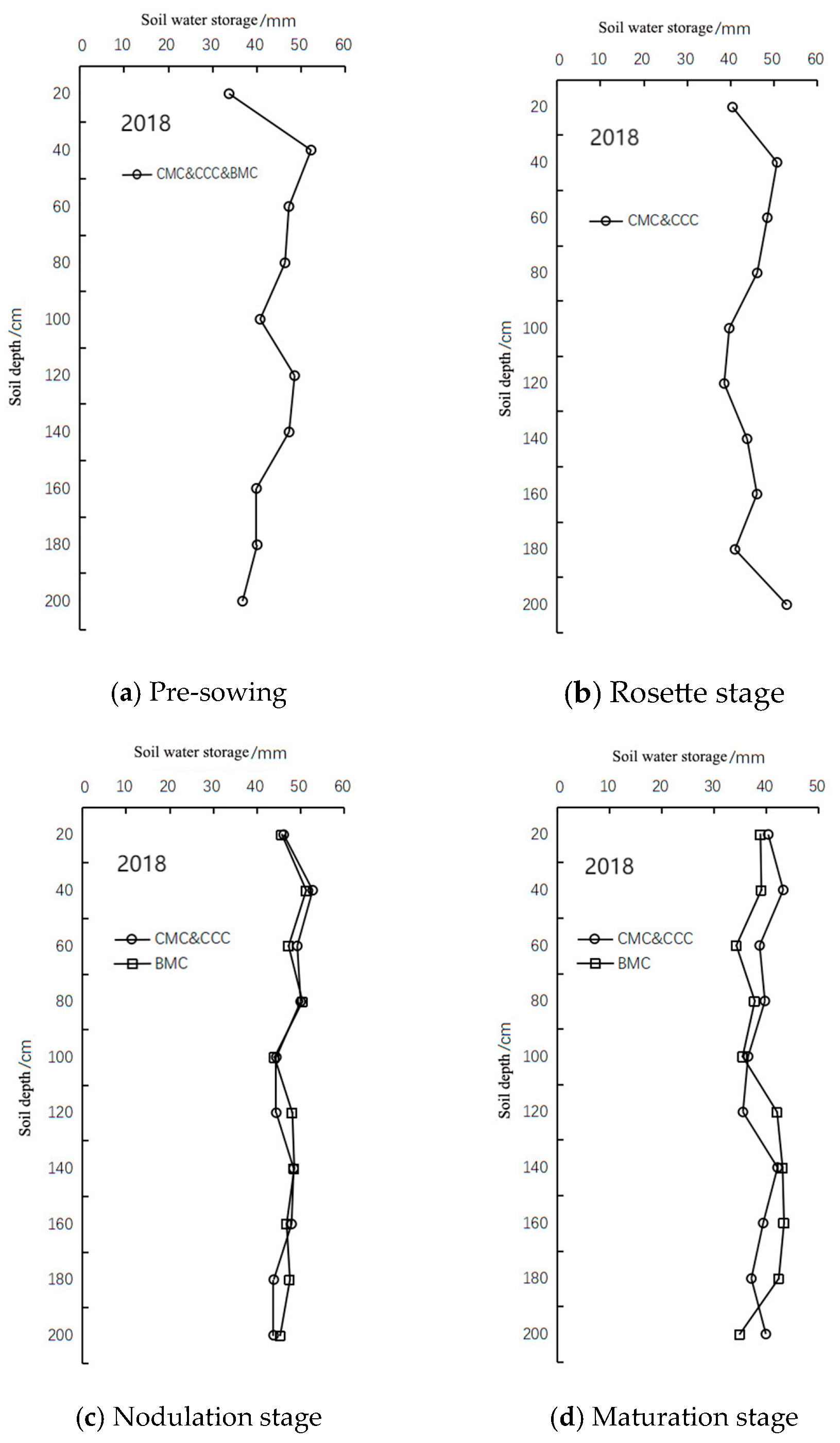
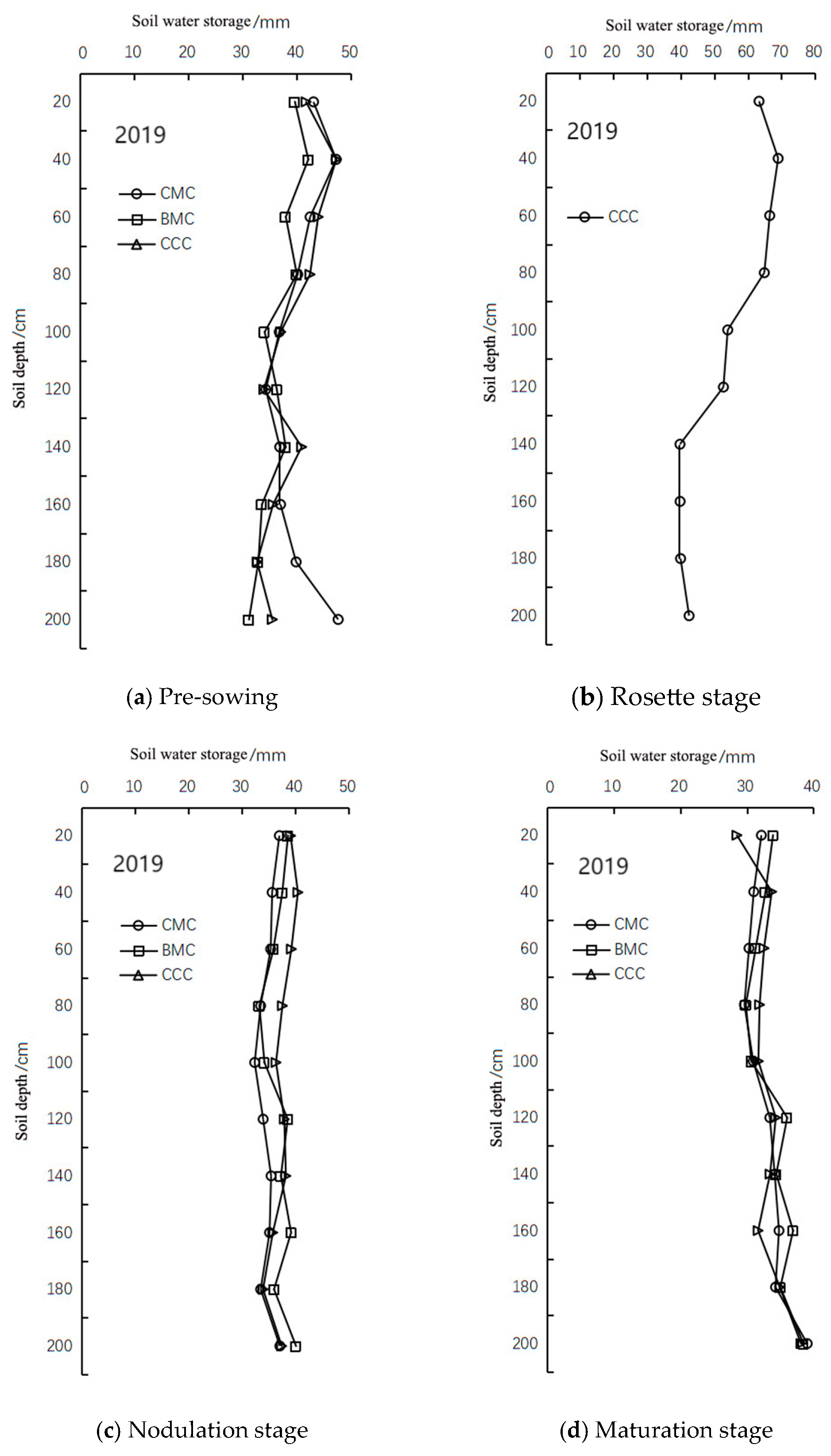
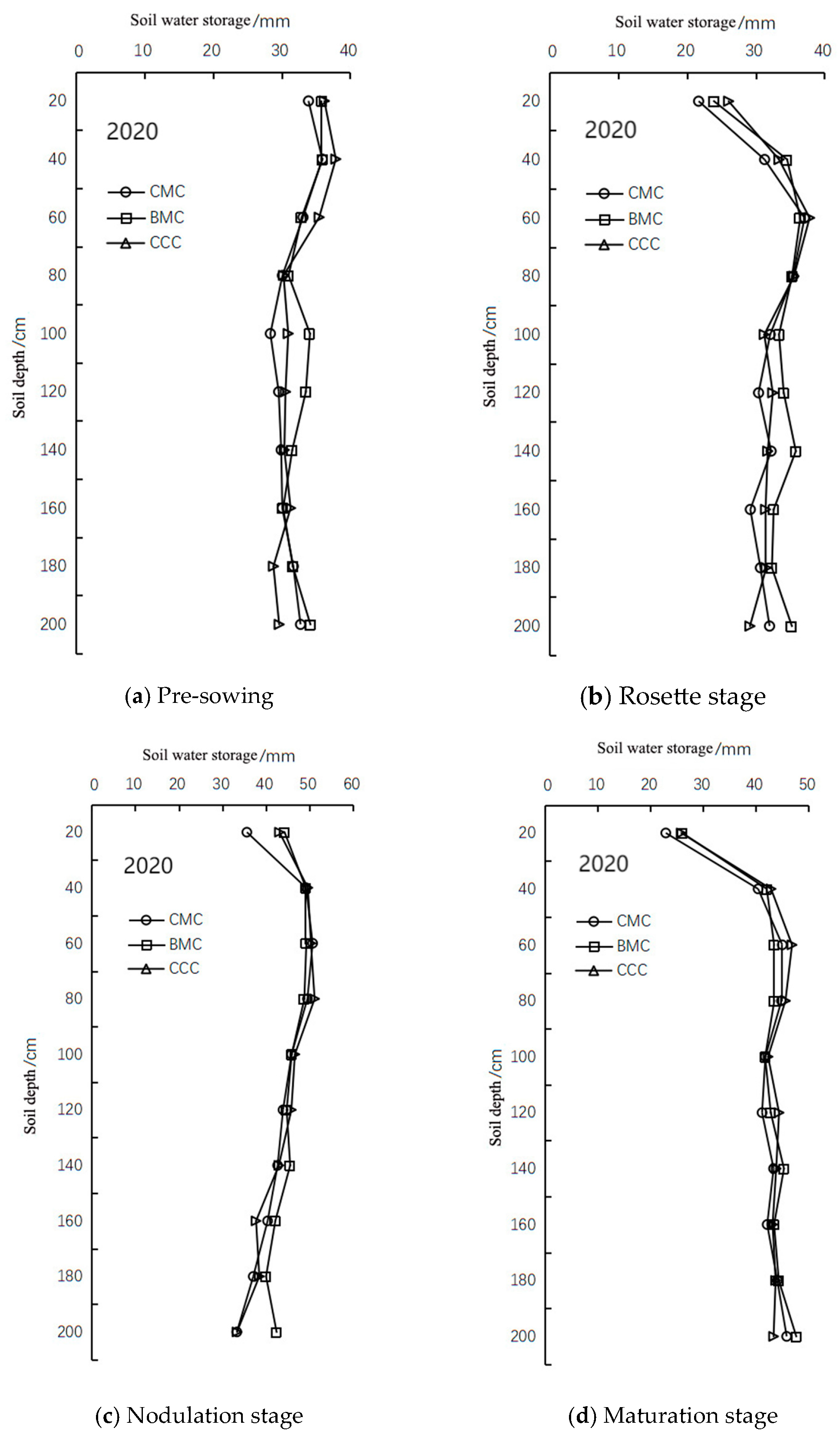
| Treatment | 2018 | 2019 | 2020 |
|---|---|---|---|
| CMC | Cabbage | Maize | Cabbage |
| BMC | Beans | Maize | Cabbage |
| CCC | Cabbage | Cabbage | Cabbage |
| Year | Treatment | Seeding Stage—Rosette Stage | Rosette Stage—Nodulation Stage | Nodulation Stage—Maturation Stage | |||
|---|---|---|---|---|---|---|---|
| Evapotranspiration/mm | Rainfall/mm | Evapotranspiration/mm | Rainfall/mm | Evapotranspiration/mm | Rainfall/mm | ||
| 2018 | CMC and CCC | 31.3 b | 46.2 | 155.4 a | 178.5 | 115.3 a | 37.1 |
| 2019 | CCC | 107.5 a | 248.3 | 158.0 a | 2.2 | 72.9 a | 28.3 |
| 2020 | CMC | 133.8 a | 130.3 | 13.3 b | 128.6 | 105.8 a | 89.5 |
| BMC | 127.8 a | 130.3 | 10.9 b | 128.6 | 120.9 a | 89.5 | |
| CCC | 131.6 a | 130.3 | 10.7 b | 128.6 | 106.2 a | 89.5 | |
| Year | Treatment | Yield (kg/ha) | Cultivation Costs (Yuan) | Corp Prices (Yuan/kg) | Economic Benefit (Yuan/ha) | Evapotranspiration during the Growth Periods of Crops (mm) | Water Use Efficiency (kg·(ha·mm)−1) |
|---|---|---|---|---|---|---|---|
| 2018 | CMC and CCC | 67,944.4 | 661.25 | 1.3 | 87,666.48 | 302.1 d | 225.39 b |
| BMC | 10,222.2 | 1164.31 | 6.3 | 63,235.55 | 303.5 d | 33.72 c | |
| 2019 | CMC | 20,600.0 | 1112.80 | 2.0 | 40,087.20 | 433.6 a | 47.54 c |
| BMC | 18,450.0 | 1112.80 | 2.0 | 35,787.20 | 384.4 b | 47.96 c | |
| CCC | 83,055.6 | 626.37 | 1.0 | 82,429.23 | 338.4 c | 247.74 ab | |
| 2020 | CMC | 69,916.0 | 506.67 | 1.6 | 111,358.93 | 252.9 e | 276.75 a |
| BMC | 64,554.9 | 506.67 | 1.6 | 102,781.17 | 259.6 e | 248.83 ab | |
| CCC | 69,388.2 | 506.67 | 1.6 | 110,514.45 | 248.5 e | 279.31 a |
Disclaimer/Publisher’s Note: The statements, opinions and data contained in all publications are solely those of the individual author(s) and contributor(s) and not of MDPI and/or the editor(s). MDPI and/or the editor(s) disclaim responsibility for any injury to people or property resulting from any ideas, methods, instructions or products referred to in the content. |
© 2024 by the authors. Licensee MDPI, Basel, Switzerland. This article is an open access article distributed under the terms and conditions of the Creative Commons Attribution (CC BY) license (https://creativecommons.org/licenses/by/4.0/).
Share and Cite
Wang, X.; Wang, T.; Wang, L.; Liu, E. The Effects of Different Rotations of Beans, Maize, and Cabbage on Soil Moisture and Economic Benefits. Agronomy 2024, 14, 479. https://doi.org/10.3390/agronomy14030479
Wang X, Wang T, Wang L, Liu E. The Effects of Different Rotations of Beans, Maize, and Cabbage on Soil Moisture and Economic Benefits. Agronomy. 2024; 14(3):479. https://doi.org/10.3390/agronomy14030479
Chicago/Turabian StyleWang, Xiaojuan, Tianle Wang, Lei Wang, and Enke Liu. 2024. "The Effects of Different Rotations of Beans, Maize, and Cabbage on Soil Moisture and Economic Benefits" Agronomy 14, no. 3: 479. https://doi.org/10.3390/agronomy14030479






